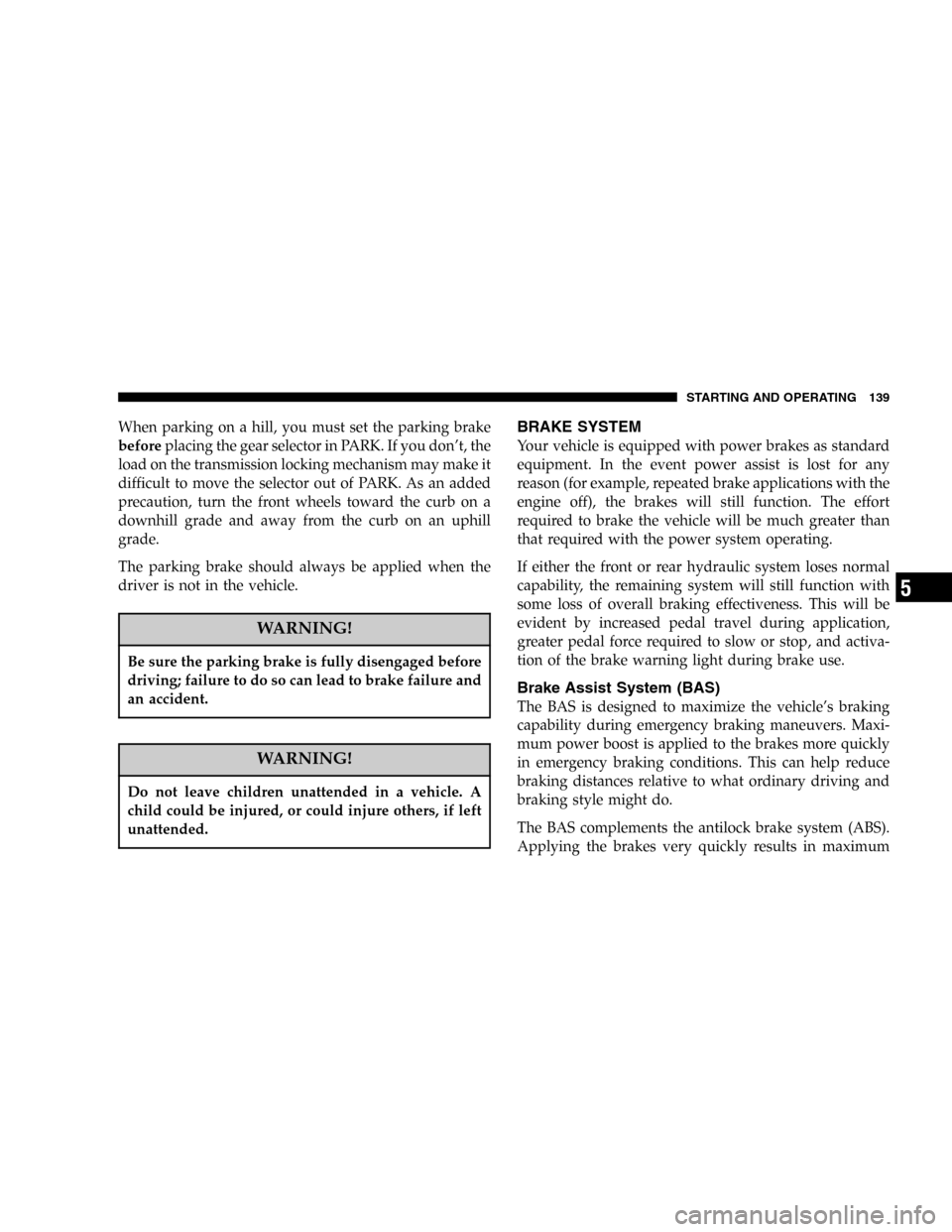Page 128 of 280

▫ESP Control Switch....................143
▫Anti-Lock Brake System (ABS)............144
▫Brake Pad Break-In....................147
�Power Steering........................147
�Ti re s................................148
▫Tire Pressure.........................148
▫Tire Inflation Pressures.................149
▫Radial-Ply Tires......................151
▫Tire Spinning........................151
▫Tire Pressure Monitor System.............151
▫Tire Chains..........................153
▫Original Equipment Tires................153
▫Snow Tires..........................154
▫Tread Wear Indicators..................155▫Replacement Tires.....................155
▫Tire Rotation Recommendations...........156
▫Alignment And Balance.................157
�Fuel Requirements.....................158
▫Reformulated Gasoline.................158
▫Gasoline/Oxygenate Blends..............158
▫MMT In Gasoline.....................159
▫Materials Added To Fuel................159
▫Sulfur In Gasoline.....................159
�Adding Fuel..........................160
▫Fuel Filler Cap (Gas Cap)...............160
�Vehicle Loading.......................162
▫Roof Luggage Rack....................162
�Trailer Towing........................163
128 STARTING AND OPERATING
Page 129 of 280

STARTING PROCEDURES
WARNING!
Do not leave animals or children inside parked
vehicles in hot weather; interior heat build up may
cause serious injury or death.
Be sure that the parking brake is engaged and that
selector lever is in the NEUTRAL or PARK position. Turn
the key in the ignition switch to the ON/RUN position.
Apply the brakes before shifting into any driving gear.
Normal Starting
Do not depress the accelerator. Simply turn the key in the
ignition switch clockwise to the START position and
release when the engine starts. If the engine will not run,
turn the key counterclockwise to the OFF/LOCK posi-
tion and repeat the starting procedure. If there are several
unsuccessful attempts, have the system checked at the
nearest authorized dealer.
NOTE:Due to the starter non-repeat feature, the key
must be turned completely to the left before attempting
to start the engine again.
Extremely Cold Weather (below -20°For-29°C)
For reliable starting in areas where temperatures fre-
quently drop below -20°F (-29°C), we recommend the use
of an externally powered battery and an electric engine
block heater. Advice on these items and installation is
available at your authorized dealer.
STARTING AND OPERATING 129
5
Page 131 of 280
After Starting
The idle speed will automatically decrease as the engine
warms up.
TRANSMISSION SHIFTING
WARNING!
When leaving the vehicle, always remove the key
from the ignition switch, and lock the vehicle. Do
not leave children unattended in the vehicle, or with
access to an unlocked vehicle. Children could move
the gearshift lever, which could result in an accident
or serious injury.
Automatic Transmission
The automatic transmission selects individual gears au-
tomatically, dependent upon:
•Selector lever position
•Program mode selector switch
•Accelerator position
•Vehicle speed
STARTING AND OPERATING 131
5
Page 132 of 280

The gear shifting process is continuously adapted, de-
pendent on the driving style, the driving situation and
the road characteristics.
The selector lever is automatically locked while in the
PARK position. To move the selector lever out of the
PARK position, the brake pedal must be firmly depressed
before the shift lock will release.
Shift the selector lever to the desired position only when
the engine is idling normally and the brake pedal is
applied. Do not release the brake until ready to drive. The
vehicle may otherwise accelerate quickly when the selec-
tor lever is in DRIVE or REVERSE position.
NOTE:After selecting any driving position, wait a
moment to allow the gear to fully engage before acceler-
ating, especially when the engine is cold.
WARNING!
It is dangerous to shift the selector lever out of PARK
or NEUTRAL if the engine speed is higher than idle
speed. If your foot is not firmly on the brake pedal,
the vehicle could accelerate quickly forward or in
reverse. You could lose control of the vehicle and hit
someone or something. Only shift into gear when
the engine is idling normally and when your foot is
firmly on the brake pedal.
Stopping
For brief stops, leave the transmission in gear and hold
the vehicle with the brake pedal. For longer stops with
the engine idling, shift into the NEUTRAL or PARK
position and hold the vehicle with the parking brake.
When stopping the vehicle uphill, do not hold it with the
accelerator; use the brake. This avoids unnecessary trans-
mission heat build-up.
132 STARTING AND OPERATING
Page 133 of 280

Maneuvering
To maneuver in tight areas, control the vehicle speed by
gradually releasing the brakes. Accelerate gently and
never abruptly step on the accelerator.
To rock a vehicle out of soft ground (mud or snow),
alternately shift from forward to reverse, while applying
only slight acceleration. Rocking a vehicle free in this
manner may cause the ABS or traction system malfunc-
tion indicator light to come on. Turn off the engine and
restart the engine to clear the malfunction indication.
Park Position
The PARK position is to be used when parking the
vehicle. Engage only with the vehicle stopped. The PARK
position is not intended to serve as a brake when the
vehicle is parked. Rather, the driver should always use
the parking brake in addition to placing the selector lever
in PARK to secure the vehicle.
NOTE:The key can be removed from the ignition
switch only with the selector lever in the PARK position.
With the key removed, the selector lever is locked in the
PARK position.
With a malfunction in the vehicle’s electrical system, the
selector lever could remain locked in the PARK position.
To unlock the selector lever manually, insert the end of
the multipurpose tool from the glove box (or ball point
pen) into the covered opening below the position“D”of
the shift pattern. While pushing the tool down, move the
selector lever out of the PARK position. After removal of
STARTING AND OPERATING 133
5
Page 136 of 280
Gear Ranges
“P”PARK
NOTE:If the key is in the ON/RUN position, you must
press the brake pedal to shift out of the PARK position.
PARK supplements the parking brake by locking the
transmission. The engine can be started in this range.
Never attempt to use PARK while the vehicle is in
motion.
Apply the parking brake when leaving the vehicle in this
range.
“R”REVERSE
Shift into this range only after the vehicle has come to a
complete stop.
“N”NEUTRAL
The engine may be started in this range. Use this range
for starting your vehicle if it is moving or being towed.“D”OVERDRIVE
This range should be used for most city and highway
driving. It provides the smoothest upshifts and down-
shifts and best fuel economy.
Program mode selector switch
The transmission is provided with a selector switch for
Standard“S”and Winter/Wet“W”(snow and ice) pro-
gram modes.
136 STARTING AND OPERATING
Page 138 of 280

4. Wait approximately 10 seconds.
5. Restart the engine.
6. Move the selector lever to the DRIVE position (for
SECOND gear), or move the selector lever to the RE-
VERSE position (for REVERSE gear).
Have the transmission checked at your authorized dealer
as soon as possible.
PARKING BRAKE
When you apply the parking brake with engine
running, the brake system warning light in the
instrument cluster will come on.
NOTE:This light, when illuminated with parking brake
application, shows only that the parking brake is on. It
does not show the degree of brake application.
NOTE:If the light remains on with the parking brake
released, a brake system malfunction is indicated. Have
the brake system serviced by an authorized dealer im-
mediately.Before leaving the vehicle, make sure that the parking
brake is fully applied and place the gear selector in the
PARK position.
To release the parking brake, slightly pull up the handle
while pushing the lock button, and guide the lever
downward to its stop. The brake warning light in the
instrument cluster should go out.
A warning sounds if you start to drive without having
released the parking brake.
138 STARTING AND OPERATING
Page 139 of 280

When parking on a hill, you must set the parking brake
beforeplacing the gear selector in PARK. If you don’t, the
load on the transmission locking mechanism may make it
difficult to move the selector out of PARK. As an added
precaution, turn the front wheels toward the curb on a
downhill grade and away from the curb on an uphill
grade.
The parking brake should always be applied when the
driver is not in the vehicle.
WARNING!
Be sure the parking brake is fully disengaged before
driving; failure to do so can lead to brake failure and
an accident.
WARNING!
Do not leave children unattended in a vehicle. A
child could be injured, or could injure others, if left
unattended.
BRAKE SYSTEM
Your vehicle is equipped with power brakes as standard
equipment. In the event power assist is lost for any
reason (for example, repeated brake applications with the
engine off), the brakes will still function. The effort
required to brake the vehicle will be much greater than
that required with the power system operating.
If either the front or rear hydraulic system loses normal
capability, the remaining system will still function with
some loss of overall braking effectiveness. This will be
evident by increased pedal travel during application,
greater pedal force required to slow or stop, and activa-
tion of the brake warning light during brake use.
Brake Assist System (BAS)
The BAS is designed to maximize the vehicle’s braking
capability during emergency braking maneuvers. Maxi-
mum power boost is applied to the brakes more quickly
in emergency braking conditions. This can help reduce
braking distances relative to what ordinary driving and
braking style might do.
The BAS complements the antilock brake system (ABS).
Applying the brakes very quickly results in maximum
STARTING AND OPERATING 139
5